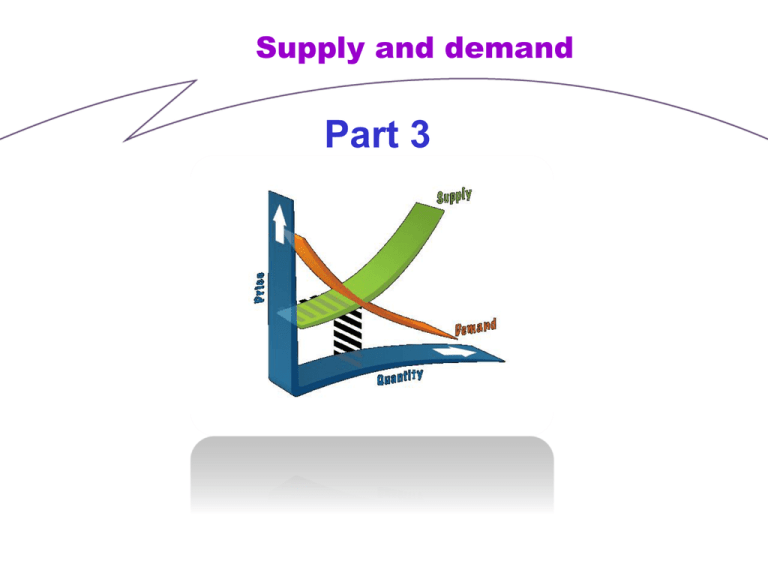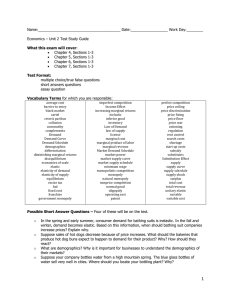Supply and demand
advertisement

Supply and demand Part 3 Underlying assumptions in economic theory The underlying value judgement Individual (Homo oeconomicus hypothesis) sovereignty: Resources should be allocated according to what people want. (Pareto-efficiency) The underlying concept Opportunity costs: In order to consume more of good 1 (e.g., boats) you have to give up some consumption of good 2 (e.g., environmental quality or leisure). Let’s go deeper into demand Individuals have preferences over goods & services including the environment. It’s all based on UTILITY The individual preferences can be translated into an willingness to pay (WTP), reflecting the individual benefits from consumption. Generally, the marginal willingness to pay declines with the amount consumed. Let us ignore the environment for the time being. From individual needs to an aggregated demand curve ! law of diminishing returns Gossen's First Law is the “law” of diminishing marginal utility: that marginal utilities are diminishing across the ranges relevant to decision-making. Gossen's Second Law, which presumes that utility is at least weakly quantified, is that in equilibrium an agent will allocate expenditures so that the ratio of marginal utility to price (marginal cost of acquisition) is equal across all goods and services. example Benefits and Costs Marginal WTP 50 1 Aggregated demand curve Quantity Benefits and Costs Marginal WTP 50 Aggregated demand curve 42 12 Quantity Benefits and Costs Marginal WTP 50 Aggregated demand curve 42 35 WTP 10 Quantity Benefits and Costs Marginal WTP 50 Aggregated demand curve 42 35 WTP 10 Quantity Benefits and Costs Marginal WTP 50 Aggregated demand curve 42 35 WTP 10 Quantity Benefits and Costs Marginal WTP 50 Aggregated demand curve 42 35 WTP 10 Quantity Question: How do we get to know the marginal willingness to pay of somebody? Benefits and Costs Marginal WTP Aggregated demand curve Linear relationship This makes it easier for us to handle! WTP Quantity 10 Benefits and Costs Summing up individual WTP yields total WTP. Total willingness to pay is equal to total benefits from consumption. Total (marginal) WTP provides a measure of a society’s benefits from consumption. Benefits and Costs The production side: The available technologies determine the production possibilities. Producing goods/services implies (opportunity) costs Marginal cost curve shows the costs of producing one additional unit. Marginal costs are non-decreasing with output. Total costs are the sum of marginal costs. Benefits and Costs Relationship of marginal to total costs Marginal Costs Marginal Costs Total Costs Quantity 20 Socially Optimal Outcome Calculation of net benefits: total (aggregate) net benefits = total (aggr.) benefits – total costs Efficiency: An allocation is efficient if this allocation maximises net benefits. Optimality condition: Net benefits are maximised if marginal benefits equal marginal costs. Socially Optimal Outcome Derivation of net benefits Marginal WTP/Costs Net Benefit Maximum price Total Costs Quantity Q* Additional reading for those interested: • Duncan Kennedy, Cost-Benefit Analysis of Entitlement Problems: A critique; Stanford Law Review, Vol. 33, No. 3 (Feb., 1981), pp. 387-445 Stable URL: http://www.jstor.org/stable/1228354 Why is the market economy best in theory? Both consumers and producers are better off because there is a market in this good, i.e. there are gains from trade. The maximum possible total surplus (highest possible gain to society) is achieved at market equilibrium. In the market equilibrium there is no way to make some people better off without making others worse off markets are efficient. (no pareto optimum possible) The benifits of the market system Example: Market for books Two cases It’s all about books Situation No. 1 “Demand”: We have a market for books. Imagine we would take an economics book from Mia (who bought it) and give it to Bob, who thought it is too expensive. What are the effects? Reallocating consumption lowers consumer surplus Case No. 2 Situation No. 2 “Supply”: Two booksellers (Yvonne & Xavier) are competing on the market. Imagine Yvonne would be forced to sell her book instead of Xavier. What would be the effect? Reallocating Sales Lowers Producer Surplus The market performs 4 important functions It allocates consumption of the good to the potential buyers who value it the most. It allocates sales to the potential sellers who most value the right to sell the good. It ensures that every consumer who makes a purchase values the good more than every seller who makes a sale. It ensures that every potential buyer who doesn’t make a purchase values the good less than every potential seller who doesn’t make a sale. Freakonomics blog What problems to exist if we deal with supply and demand ? Refer to problems mentioned in the articles Links to articles • http://www.freakonomics.com/2012/02/01/are-superbowl-ads-too-cheap/ • http://www.freakonomics.com/2012/01/12/theeconomics-of-prostitution-belle-epoque-edition/ • http://www.freakonomics.com/2011/12/02/why-doesa-caucasian-dollhouse-cost-nearly-70-more-than-anafrican-american-dollhouse/ Defining and Measuring Elasticity The price elasticity of demand is the ratio of the percent change in the quantity demanded to the percent change in the price as we move along the demand curve. Different Different values values for for elasticity elasticity Different Different values values for for elasticity elasticity Different values for elasticity Interpreting the Price Elasticity of Demand: How Elastic Is Elastic? Demand is: elastic if the price elasticity of demand is greater than 1, inelastic if the price elasticity of demand is less than 1, and unit-elastic (or iso-elastic) if the price elasticity of demand is exactly 1. Price Elasticity of Supply …and nearly the same, just the other way around… The price elasticity of supply is a measure of the responsiveness of the quantity of a good supplied to the price of that good. Quick review of demand Review: Demand curve illustrates relationship between price & quantity demanded The „law of demand“ asserts that demand curves normally slope downward higher price, fewer quantity Increase in demand right-shift of the curve Decrease in demand left-shift of the curve 4 main factors that can shift the curve: (1) price of a related good: substitute or complement (2) income (3) tastes and (4) expectations Quick review of supply Review: supply curve illustrates relationship between price and quantity supplied The supply curves are normally sloping upwards higher price, more quantity offered Increase in supply right-shift of the curve Decrease in supply left-shift of the curve 3 main factors that can shift the curve: (1) input prices (2) technology and (3) expectations A different view on supply & demand Any questions left ? 1. Introduction 2. Markets, Firms &the Role of Government 3. Global Economy I 4. Global Economy II 5. Global Economy III









